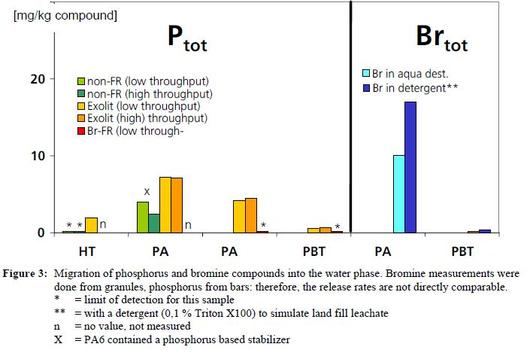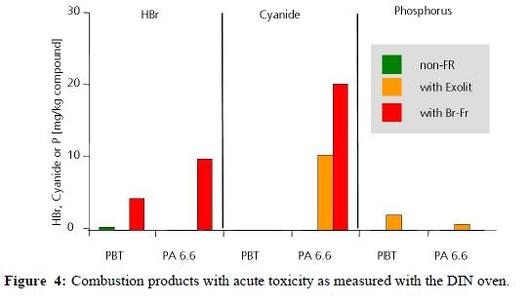Green Fire Retardants
Timber may be treated with retardants and protected such that the stage at which it begins contributing to the fire is delayed. However, by the time the fire protection is applied it is possible that the environmental credentials of timber (often a key factor in material selection) have been undermined. Although this may seem like a necessary evil, there is a growing school of thought that a “green” building should not contain toxic chemicals.
In order to enable provision of both a safe, and environmentally-friendly option, a “green” fire retardant is needed.
Halogens and the need for change
Of particular concern are Halogenated compounds (bromine/chlorine based retardants) which are both toxic and persistent. These have been recognised as harmful substances since the 1980s (15) but many variants are still available for use today: it took the EU until 2004 to ban PBDE (a particularly toxic compound). Substances like this will remain in the environment for years after migrating from the materials they originally were used to treat, posing hazards to human health and the environment.
Persistent Organic Pollutants are under constant review (the next report will be released in Geneva in April 2011 http://chm.pops.int/); this means that work has been undertaken on non-halogenated replacements for flame retardants. Nitrogen and phosphorus, as well as nanocomposites in plastics all have been studied recently.
Phosphorus has been the focus of a series of papers around Europe about sustainable flame retardants. The graphs below (16) compare some characteristics of a phosphorus-based flame retardant to a bromine-based one. It can be clearly seen that phosphorus is a lot less likely to migrate into the environment, and contributes less harmful gases during combustion, making it a safer retardant option.
In order to enable provision of both a safe, and environmentally-friendly option, a “green” fire retardant is needed.
Halogens and the need for change
Of particular concern are Halogenated compounds (bromine/chlorine based retardants) which are both toxic and persistent. These have been recognised as harmful substances since the 1980s (15) but many variants are still available for use today: it took the EU until 2004 to ban PBDE (a particularly toxic compound). Substances like this will remain in the environment for years after migrating from the materials they originally were used to treat, posing hazards to human health and the environment.
Persistent Organic Pollutants are under constant review (the next report will be released in Geneva in April 2011 http://chm.pops.int/); this means that work has been undertaken on non-halogenated replacements for flame retardants. Nitrogen and phosphorus, as well as nanocomposites in plastics all have been studied recently.
Phosphorus has been the focus of a series of papers around Europe about sustainable flame retardants. The graphs below (16) compare some characteristics of a phosphorus-based flame retardant to a bromine-based one. It can be clearly seen that phosphorus is a lot less likely to migrate into the environment, and contributes less harmful gases during combustion, making it a safer retardant option.
Predicting the behaviour of a retardant during its life is clearly an important parameter. Part of the issues with halogen retardants is that their movement is difficult to predict due to their migratory nature, and as such they have been found in high quantities in unusual places. The possibility of halogen retardants as a cancer-causing agent makes this knowledge even more unsettling.
Products
One product that has recently marketed itself as a green fire retardant is Flamebloc GS® by Buckman. This product claims to be halogen-free and contain no VOCs (Volatile Organic Compounds). By intumescing and charring, the retardant slows burning and flame spread, important processes for protecting structural timber from direct heat.
This is an interesting development, as Flameboc GS® claims to be applicable to a variety of situations, including as a retardant for timber, where it may upgrade the material to Class A from Class C (US Standard). The guidance also states that Flamebloc GS® may be used externally if a coating is provided: this could enable application on key structural elements during the construction phase.
Research is being undertaken by several companies developing “green” retardants, although due to the different retardant types not all of these will be applicable to timber. Paxymer® (www.paxymer.se) and Exolit® (www.exolit.com) also claim to be green retardants, although their application is limited to plastics.
Although there are clearly several green fire retardant options becoming available, it is vital that the fire performance requirement is not overlooked. Bromine-based compounds have been used so widely because of their fire retarding capabilities, and any new retardants should ideally not be compromised by lower levels of protection.
Products
One product that has recently marketed itself as a green fire retardant is Flamebloc GS® by Buckman. This product claims to be halogen-free and contain no VOCs (Volatile Organic Compounds). By intumescing and charring, the retardant slows burning and flame spread, important processes for protecting structural timber from direct heat.
This is an interesting development, as Flameboc GS® claims to be applicable to a variety of situations, including as a retardant for timber, where it may upgrade the material to Class A from Class C (US Standard). The guidance also states that Flamebloc GS® may be used externally if a coating is provided: this could enable application on key structural elements during the construction phase.
Research is being undertaken by several companies developing “green” retardants, although due to the different retardant types not all of these will be applicable to timber. Paxymer® (www.paxymer.se) and Exolit® (www.exolit.com) also claim to be green retardants, although their application is limited to plastics.
Although there are clearly several green fire retardant options becoming available, it is vital that the fire performance requirement is not overlooked. Bromine-based compounds have been used so widely because of their fire retarding capabilities, and any new retardants should ideally not be compromised by lower levels of protection.


